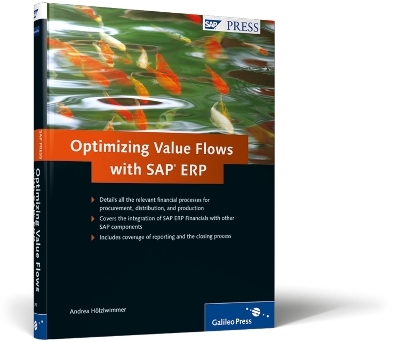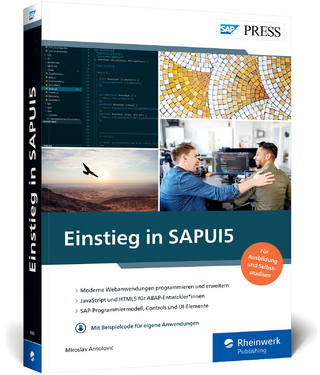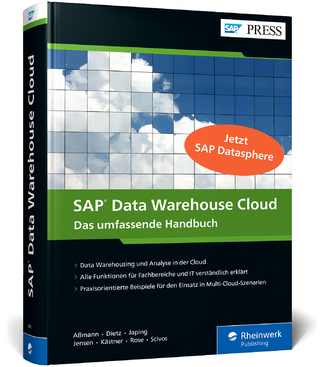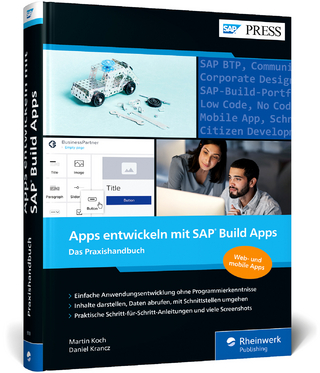
Optimizing Value Flows with SAP ERP
SAP Press (Verlag)
978-1-59229-298-1 (ISBN)
- Titel ist leider vergriffen;
keine Neuauflage - Artikel merken
Andrea Hoelzlwimmer is a financial consultant at J & M Management Consulting. She has many years of experience in finance and with the SAP Financial Accountingand Controlling components.
Acknowledgments 13
Foreword 15
1 Introduction 17
1.1 Content and Structure 18
1.2 Lederwaren-Manufaktur Mannheim 20
2 The Concept of Integrated Value Flows 25
2.1 Explanation of the Term ""Integrated Value Flow"" 25
2.1.1 Value Flow 26
2.1.2 Integration 28
2.2 Models for Representing Enterprise Processes 30
2.2.1 Porter's Value Chain Model 30
2.2.2 SCOR Model 31
2.3 Extending the SCOR Model 36
2.4 Interaction Between Process Design and Controlling Approach 37
2.5 Summary 39
3 Basic Principles of Integration in SAP ERP 41
3.1 Structure of SAP Systems 42
3.2 Entity Model 43
3.2.1 Organizational Elements in the SAP System 44
3.2.2 Organizational Elements and Enhancements of the Standard SAP System 51
3.2.3 Excursus: The SAP General Ledger and Changes to the Organizational Structure 52
3.3 International Requirements 53
3.3.1 Parallel Accounting using the Classic General Ledger 54
3.3.2 Options of the SAP General Ledger for the Parallel Rendering of Accounts 56
3.4 Value Flow-Oriented Master Data Concept 58
3.4.1 General Ledger Account and Cost Element 59
3.4.2 Chart of Accounts 63
3.4.3 Material Master 65
3.4.4 Requirements Class 71
3.5 CO-PA as a Central Reporting Tool 73
3.5.1 Forms of CO-PA 74
3.5.2 Structure of Costing-Based CO-PA 75
3.6 Summary 83
4 Procurement Process 85
4.1 Procurement Process in the SCOR Model 86
4.2 Vendor Master as an Integrative Element 89
4.3 Purchase Order as the Basis of the Procurement Process 92
4.3.1 Purchase Requisition 92
4.3.2 Purchase Order 92
4.4 Updating Commitments 98
4.5 Integration of MM and Financial Accounting/Controlling 104
4.5.1 Basic Settings 105
4.5.2 Valuation Class Settings 109
4.5.3 Determining Transactions 114
4.5.4 Rebuild Process for Account Determination 123
4.6 Goods Receipt 128
4.7 Invoice Verification 130
4.7.1 Invoice Verification Process 131
4.7.2 Considering Tolerances 138
4.7.3 Automatically Releasing Blocked Invoices 141
4.8 GR/IR Account 142
4.8.1 Posting to the GR/IR Account 142
4.8.2 Clearing the GR/IR Account 143
4.9 Integration of Accounts Payable Accounting 147
4.9.1 Invoice Receipt Without MM Integration 148
4.9.2 Outgoing Payments 149
4.10 Mapping the Tax on Sales/Purchases 154
4.11 Summary 157
5 Sales and Distribution Process 159
5.1 Sales and Distribution Process in the SCOR Model 160
5.2 Sales Order as the Basis of Further Account Assignment 162
5.2.1 Profit Center Derivation 163
5.2.2 Deriving a Segment 164
5.3 Price Determination as the Basis of Value Determination 166
5.3.1 Conditions and Costing Sheet 166
5.3.2 Price-Determining Elements 170
5.3.3 Costing-Based Elements 173
5.3.4 Special Business Transactions 175
5.4 Goods Issue 178
5.5 Presentation of Receivables 182
5.5.1 Customer Account 183
5.5.2 Determining the Reconciliation Account 186
5.5.3 Integration of SD and Accounts Receivable 193
5.5.4 Mapping of Secondary Businesses 194
5.5.5 Dunning 195
5.5.6 Incoming Payment 196
5.6 Mapping Sales Revenues 204
5.6.1 Time of the Revenue Recognition 204
5.6.2 Presentation of Sales Revenues 205
5.6.3 Transfer to Overhead Cost Controlling 216
5.6.4 Troubleshooting for Revenue Account Determination 218
5.7 Summary 219
6 Production Process 221
6.1 Production Process in the SCOR Model 223
6.2 Basic Product Cost Controlling Data 225
6.2.1 Logistical Master Data 225
6.2.2 Prerequisites in Controlling 229
6.2.3 Basic Product Cost Controlling Settings 231
6.3 Product Cost Planning 241
6.3.1 Types of Product Cost Planning 241
6.3.2 Material Cost Estimate with Quantity Structure 244
6.3.3 Simulation and Base Planning Object 251
6.4 Cost Object Controlling 257
6.4.1 Cost Object Controlling Functions in SAP ERP 257
6.4.2 Period-End Closing 262
6.4.3 Period-Related Product Controlling 281
6.4.4 Order-Related Product Controlling 287
6.4.5 Product Cost by Sales Order 292
6.5 Summary 297
7 Closing and Reporting in SAP ERP 299
7.1 Innovations in SAP General Ledger 300
7.1.1 Activating Different Scenarios 300
7.1.2 Effect of Real-Time Integration of Controlling with Financial Accounting 302
7.2 HR Data Transfer 312
7.3 Inventory 315
7.4 Activities in Asset Accounting 317
7.4.1 Settlement of Assets Under Construction 317
7.4.2 Depreciation Posting Run 320
7.4.3 Periodic APC Values Posting 323
7.4.4 Asset Accounting Inventory 324
7.4.5 Technical Processing 324
7.4.6 Creating the Asset History Sheet 325
7.5 Period Control 326
7.5.1 Period Closing for the Material Master 327
7.5.2 Opening and Closing Posting Periods 327
7.6 Foreign Currency Valuation 329
7.7 Reclassification of Receivables and Payables 333
7.8 Value Adjustment to Receivables 334
7.9 Balance Carryforward 335
7.10 Manual Postings 336
7.11 Assessments and Distributions 338
7.12 Reconciliation 341
7.12.1 Accounting Reconciliation 341
7.12.2 Intercompany Reconciliation 342
7.12.3 Reconciliation Between Financial Accounting and Inventory Management 343
7.12.4 Reconciliation Between Financial Accounting and Controlling 344
7.13 Reporting 345
7.13.1 Reporting in General Ledger Accounting 345
7.13.2 Reporting in Open Item Accounting 349
7.13.3 Reporting in Controlling 349
7.14 Summary 351
8 Reporting with SAP NetWeaver BW 353
8.1 Basic Principles of Business Intelligence 353
8.1.1 Business Explorer Suite Reporting with SAP NetWeaver BW 361
8.1.2 Business Content 364
8.2 Data Acquisition Examples 369
8.2.1 Financial Reporting 369
8.2.2 Profitability Analysis 373
8.3 Summary and Outlook 378
9 Optimizing Value Flows by Implementing the SAP General Ledger A Real-Life Example 379
9.1 Project Charter 379
9.1.1 Preliminary Considerations 380
9.1.2 Actual Project Scope 384
9.2 Project Plan 385
9.2.1 Project Plan 387
9.2.2 Test Phases 388
9.3 Redesigning Value Flows 391
9.3.1 Concept for Segment Derivation 391
9.3.2 Value Flows in the Procurement Process 393
9.3.3 Value Flows in the Sales Process 394
9.3.4 Value Flows in Financial Accounting and Controlling 396
9.4 Project Review 397
9.5 Summary 397
Appendices 399
A Sample Closing Procedure Document 401
B Transactions and Menu Paths 407
B.1 Controlling 407
B.2 Financial Accounting 413
B.3 Materials Management 419
B.4 Production 421
B.5 Sales and Distribution 422
B.6 SAP NetWeaver BW Customizing in SAP ERP 424
B.7 Miscellaneous 424
C The Authors 425
Index 429
| Erscheint lt. Verlag | 30.1.2010 |
|---|---|
| Reihe/Serie | SAP Press |
| Verlagsort | Maryland |
| Sprache | englisch |
| Maße | 175 x 228 mm |
| Einbandart | gebunden |
| Themenwelt | Mathematik / Informatik ► Informatik ► Netzwerke |
| Informatik ► Weitere Themen ► SAP | |
| ISBN-10 | 1-59229-298-4 / 1592292984 |
| ISBN-13 | 978-1-59229-298-1 / 9781592292981 |
| Zustand | Neuware |
| Haben Sie eine Frage zum Produkt? |
aus dem Bereich


